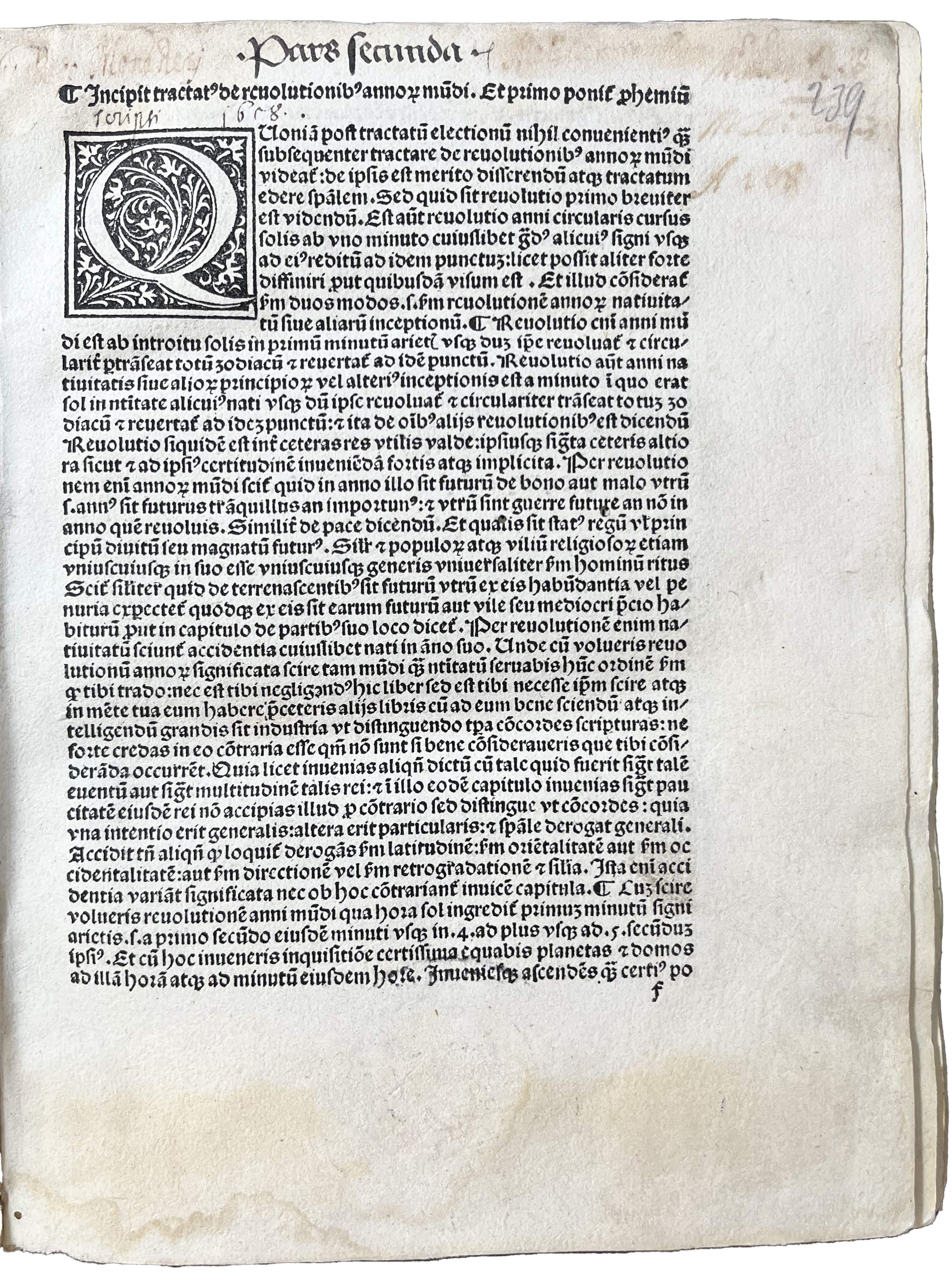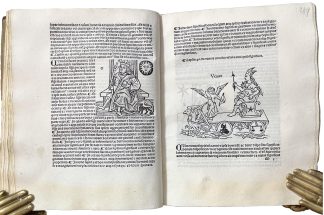BONATUS, Guidus.
ILLUSTRATED INCUNABULAR ASTRONOMY
Decem tractatus astronomiae.
Augsburg, Erhard Ratdolt, 26 Mar, 1491.£45,000.00
FIRST EDITION, first issue. 4to. 1 work in 2 vols. I: ff. [224]; II: ff. [183]. Gothic letter. Large printer’s device in red and white, a total of 183 woodcut constellations, zodiac signs or horoscope diagrams, decorated initials and ornaments. I: very light water stain to lower blank margin of first half, a few very small worm holes to first two gatherings; II: tiny mainly interlinear worm holes to initial ll., light water stain to lower blank margin, stab hole to outer blank margin of last 4 ll., last leaf starting but sound. An exceptional, crisp copy, on thick high-quality paper, in contemporary South German or Austrian quarter goatskin over wooden boards, single clasps, original wooden pegs, double blind ruled, blind-stamped lozenges and fleurons, raised bands, blind-stamped rosettes to spine compartments, early paper label with ms title to upper boards, traces of paper label to spine, small loss at head of spines, a little worming, vertical cracks to surface leather. Contemporary ms ‘His codex guidonis donatus est p[er] Reverendum dom[inum] Abbatem Gregorium Monasterij Campililiorum [Lilienfeld] venerandi(?) pr[esbiter]o Paulo Mellias Mo[na]st[er]ij Cellerano. Pars prima’ to first title, C15 ms ‘Pars secunda’, ‘scripsi 1618’ and ‘(?) Monasterij Mellicensis [Melk] hunc librum’, A108 faded at head of first leaf of II. In two folding boxes.
Remarkably good, crisp copy, in two vols, of the first edition of this very handsome, illustrated work on astronomy, and much easier to read and use in this unusual two-volume format. The early provenance, and probably the binding, can be traced to the wealthy Austrian monasteries of Lilienfeld and Melk. The most famous astrologer of the C13, the Friar Minor Guido Bonatti, from Forlì, worked for major figures like Frederick II, Holy Roman Emperor, and Guido da Montefeltro, and for several civic governments including Florence. He famously features in Dante’s ‘Divine Comedy’, residing in hell as a punishment for his astrological practices. Written in 1277, ‘Liber Astronomiae’ – his most famous work – was a standard textbook until the early C16. This first edition is illustrated with nearly 200 handsome woodcuts of planets and constellations. Divided in 6 parts, it begins with a defence of astrology and the principle that astrologers need not be expert astronomers, as well as an introduction to judicial astrology, the properties and aspects of the stars, planets and the zodiac, and the 12 Houses. Part II introduces the theory of the positions, attractions and movements of the planets for devising horoscopes. Part III goes into the detail of horoscope calculations, focusing on each of the 12 Houses and providing ‘judicia’ for a variety of events such as breastfeeding, conception, the building of churches, buying and selling, theft, hunting, etc. Part IV discusses the Revolutions of the planets and astrological predictions of future events, with chapters on comets and the significance of their tail. Part V focuses on nativities, and how the planets influence the body and mind of individuals, as shown in their horoscope, as well as their lives (e.g., number of children, time of marriage or death, etc.). Part VI discusses weather forecasts, especially rains, through astrological predictions, as ‘astrology was as close as it got to science concerning weather forecast, well into the C18’ (Cantamessa). A very attractive copy.
A 14-leaf Registrum, with a separate title and prefatory letter, here not present, was produced during printing and is frequently absent (e.g., two of the three BL copies). Its presence is now commonly taken as indicating a later issue.
ISTC ib00845000; Goff B845; HC 3461*; GfT 604; BMC II 384; GW 4643; Cantamessa 969 (2nd ed.); Riccardi I/1, 148-149 (‘rarissimo’); Houzeau-Lancaster 4160.In stock











